Animal Ag News 7/1
New Study Shows Economic Power of U.S. Corn
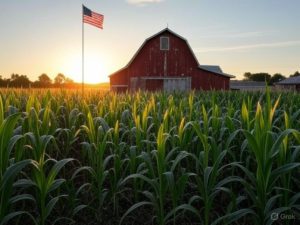 A new study released by the National Corn Growers Association (NCGA) shows corn farming is a major engine for the U.S. economy, generating an estimated $123 billion in total economic output in 2024, with an estimated contribution of $50 billion to Gross Domestic Product (GDP).
A new study released by the National Corn Growers Association (NCGA) shows corn farming is a major engine for the U.S. economy, generating an estimated $123 billion in total economic output in 2024, with an estimated contribution of $50 billion to Gross Domestic Product (GDP).
The study, entitled The Economic Value of Corn Farming in the United States for 2024, also shows that corn farming supported over 440,000 jobs and provided $29 billion in wages, strengthening communities in rural America and across the entire nation.
In 2024, corn farmers in the United States grew 14.9 billion bushels of corn for grain valued at $64.7 billion. For the 2024/25 marketing year the United States is the world’s largest producer and exporter of corn. The contribution of corn farming and linkages extended across 506 different industry sectors in all 50 states. Even Hawaii and Alaska benefit from corn farming. The states with the least economic impact from corn are actually Rhode Island and Vermont with $6.4 and 7.3 million in economic output respectively. Not surprisingly, Illinois and Iowa are the top two states, with $18.5 and 19.2 billion.
Huma Partners with John Deere Financial
 Humic products leader Huma, Inc., is partnering with John Deere Financial to offer financing programs for its full line of carbon-based crop nutrition, soil health and crop protection products.
Humic products leader Huma, Inc., is partnering with John Deere Financial to offer financing programs for its full line of carbon-based crop nutrition, soil health and crop protection products.
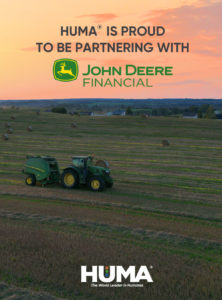 “Just in time application is a prevailing practice for crop production these days,” says Fred Nichols, Chief Sales & Marketing Officer for Huma. “John Deere Financial streamlines the purchase and financing process, making it easier for our customers to quickly and more easily improve their soil health, crop health and financial health.
“Just in time application is a prevailing practice for crop production these days,” says Fred Nichols, Chief Sales & Marketing Officer for Huma. “John Deere Financial streamlines the purchase and financing process, making it easier for our customers to quickly and more easily improve their soil health, crop health and financial health.
“Along with unmatched reach and convenience, John Deere Financial provides an excellent platform for offering very attractive purchase incentives throughout the year,” Nichols adds. “Look for some great fall offers from Huma in the upcoming months.”
Headquartered in Gilbert, Arizona, Huma is a fully integrated provider of dry and liquid humic products, operating mines in New Mexico and Idaho, and offering carbon-based humic solutions and biostimulants across the world.
Alltech Releases 2024 Sustainability Report
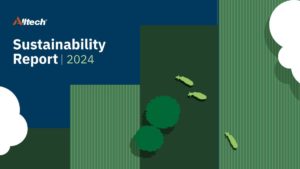 Alltech’s newly-released 2024 Sustainability Report highlights progress toward emissions reduction, champions agriculture’s role in building resilient food systems
Alltech’s newly-released 2024 Sustainability Report highlights progress toward emissions reduction, champions agriculture’s role in building resilient food systems
“Our vision of Working Together for a Planet of Plenty® recognizes that thriving farms and food businesses are essential for a more sustainable planet,” said Dr. Mark Lyons, president and CEO of Alltech. “When producers are equipped to succeed — to be profitable, to build a legacy and reinvest in their land and communities — we all move closer to a world of abundance.”
The 2024 report highlights a year of strong momentum and measurable impact: Alltech achieved double-digit business growth in 2024 while reducing its Scopes 1 and 2 emissions by 7.8%. Since 2021, Alltech has reduced those emissions by 26%, more than halfway to its 2030 target of 42%, proving that strong business performance can go hand in hand with environmental progress.
Among Alltech’s 2024 achievements, the company invested $2.04 million in six energy efficiency and renewable energy projects, cutting emissions by 3,602 metric tons of CO2-e. The company also expanded its zero-waste-to-landfill practices, with five facilities achieving full zero-waste status in 2024. In water stewardship, Alltech launched a strategy to benchmark usage, identify high-usage sites, implement conservation technologies and share global best practices.
The report also spotlights Alltech’s role in telling agriculture’s story in a new way through the World Without Cows documentary, which was viewed by more than 5,000 people last year at private screenings, film festivals and events around the world. “Through the film, its digital platform and in-person events all over the world, we are creating space for science-led storytelling that encourages critical thinking and sparking broader conversations about livestock, food security and sustainability,” Lyons said.
The film was screened at CattleCon in February where we interviewed Dr. Lyons about it.
Interview with Dr. Mark Lyons (4:59)
Industry Ag News 6/27
· Arkansas/Missouri – Dane Coomer, Piggott Arkansas; re-elected
· Kentucky – Amanda Gajdzik, Shelbyville, Kentucky; newly elected
· Ohio – Rachael Vonderhaar, Camden, Ohio; re-elected
· Tennessee – Ben Neale, Columbia, Tennessee; newly elected
DWFI Podcast 43 – Irrigation and Global Health
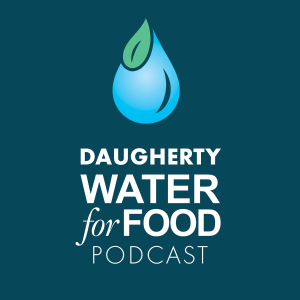 In the 43rd episode of the Water for Food Podcast, host Frances Hayes speaks with Claudia Ringler of the International Food Policy Research Institute (IFPRI) about the crucial link between irrigation and global health, expanding on Ringler’s recent Heuermann Lecture as part of the 2025 Water for Food Global Conference and previous episodes in this podcast. Together they explore how irrigation can improve health outcomes while also addressing potential unintended negative impacts and how to avoid them when designing irrigation solutions.
In the 43rd episode of the Water for Food Podcast, host Frances Hayes speaks with Claudia Ringler of the International Food Policy Research Institute (IFPRI) about the crucial link between irrigation and global health, expanding on Ringler’s recent Heuermann Lecture as part of the 2025 Water for Food Global Conference and previous episodes in this podcast. Together they explore how irrigation can improve health outcomes while also addressing potential unintended negative impacts and how to avoid them when designing irrigation solutions.
The conversation highlights successful irrigation projects, strategies for ensuring access to irrigation for beneficial outcomes like decreased malnutrition and improved hygiene, and necessary policy changes and international collaborations to maximize positive health impacts globally.
Listen here or subscribe on your favorite podcast platform:
DWFI podcast episode 43 41:23
The Robert B. Daugherty Water for Food Global Institute (DWFI) at the University of Nebraska was founded with the mission to have a lasting and significant impact on achieving more food security with less pressure on scarce water resources by conducting scientific and policy research, using the research results to inform policy makers, and sharing knowledge through education and communication.
How to subscribe:
Farmers and Ranchers Join Trump for Tax Relief
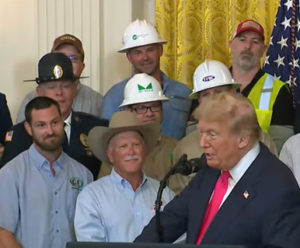
Virginia farmer Jeb Cullipher and NCBA past President Kevin Kester (left) with President Trump at White House event
President Donald Trump welcomed National Cattlemen’s Beef Association (NCBA) Past-President Kevin Kester from California and Virginia Cattlemen’s Association member Jeb Cullipher to represent those in the agriculture industry who will benefit from provisions in the legislation.
“The one big, beautiful bill will also be an incredible victory for American farmers, another group that we did great with, especially family farmers,” said President Trump. “Our bill will provide 100 percent expensing so they can buy a new farm, new farm equipment. And by the way, the expensing is good for everybody, not just farmers. And it will virtually eliminate the so-called estate tax or the death tax.”
Kester raises cattle with his wife, children, and grandchildren. Over 30 years ago, he inherited the ranch from his grandfather and faced a $2 million Death Tax from the IRS.
“It was an incredible honor to stand with President Trump and echo his message that America’s family farmers and ranchers need tax relief now,” said Kester. “When I was hit with the Death Tax 30 years ago, I couldn’t hire new employees, invest in equipment, or make improvements to the ranch. My family and I had to stretch every dollar and sacrifice basic purchases so that we could pay off that tax bill. To protect our food security and national security, we need to make sure no other farming family experiences that same burden, which is why Congress must pass the ‘One Big Beautiful Bill’ and deliver lasting tax relief.”
The Cullipher family has been farming in the area for almost 200 years and Jeb added cattle to the farm. For his business to thrive, farmers like Cullipher need Congress to support small business tax deductions, credits, and other provisions that help farmers invest in the success of their operations.
Listen to Trump’s comments here.
Pres. Trump on bill's benefits for farmers 1:53
Women in Ag Tech Returns to Tech Hub LIVE 2025
 Women in Ag Tech (WiAT) returns to Tech Hub LIVE next month in Des Moines, offering a full afternoon of inspiring conversations, actionable insights, and meaningful networking for women working in every corner of agriculture and ag tech. The event will take place Monday, July 21, from 12:30 to 5:30 p.m. at the Iowa Events Center in Des Moines.
Women in Ag Tech (WiAT) returns to Tech Hub LIVE next month in Des Moines, offering a full afternoon of inspiring conversations, actionable insights, and meaningful networking for women working in every corner of agriculture and ag tech. The event will take place Monday, July 21, from 12:30 to 5:30 p.m. at the Iowa Events Center in Des Moines.
Hosted by Meister Media Worldwide, WiAT brings together forward-thinking professionals working across precision agriculture, R&D, digital platforms, crop protection, financial services, ag retail, and farm management technologies.
Now in its third year, WiAT has become a cornerstone of Tech Hub LIVE, delivering content that’s smart, strategic, and grounded in real-world experience. From crop input innovation to data science, farm finance, and digital tools, Women in Ag Tech is built for professionals leading and shaping the future of the industry.
The agenda this year begins with a keynote address from Susan Olson, Ph.D., a former aerospace engineer who now leads ag tech startup Action Intel. Other highlights include a panel discussion on getting more value out of ag tech investments by addressing data gaps and infrastructure challenges, and a presentation from Sarah Canada with Corteva Agriscience on how innovation moves from the whiteboard to the field inside one of agriculture’s largest R&D organizations.
The program will also explore how ag tech is reshaping farm credit and insurance, from underwriting to digital documentation, and what that means for producers navigating a shifting landscape and Iowa farmer and ag advocate April Hemmes will host an open-floor Q&A, inviting attendees to ask anything—from cover crops to carbon markets to career pivots.
The Women in Ag Tech event is supported by a group of committed sponsors who continue to champion leadership, innovation, and inclusion in the sector. Corteva Agriscience returns as Signature Sponsor, joined by Agri-Access as Visionary Sponsor and Faegre Drinker as Sustaining Sponsor.
“Creating space for women to thrive in ag tech is essential to the future of the industry,” said Kristin Utterback, Innovation and Engagement Strategy Leader, R&D for Corteva. “We’re proud to support initiatives like WiAT that encourage innovation and inclusion.”
Learn more here and in the Tech Hub LIVE preview interview below with conference organizer Magda Gibson.
2025 Tech Hub LIVE preview - Magda Gibson (11:12)




